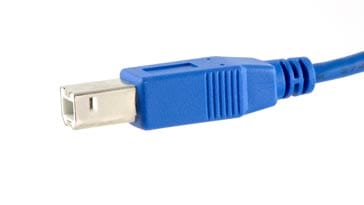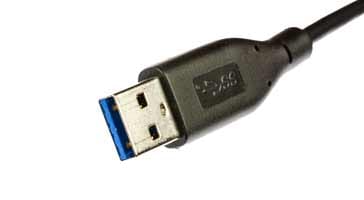USB Connectors Pinouts & Cables
There are many connector and cable options for the Universal Serial Bus, USB, the Universal Serial Bus each having standard pin connections / pinouts.
USB Universal Serial Bus Includes:
USB introduction
USB standards
Connectors, pinouts & cables
Data transfer & protocol
USB 3
USB-C
USB hubs
How to buy best USB hub
There are a number of different types of USB connector that are used on different types of equipment and in different situations. As USB has developed, new connectors have been introduced, generally reducing the connector size.
Apart from the connectors that are standardised, the cable lengths are also defined: the maximum allowable length for an individual cable is 5 metres (3 metres for slow devices) and this allows the USB data acquisition module to be located remotely from the computer.

Like all connectors, those used for USB have male and female versions to ensure that devices are mated in the correct direction.
USB upstream & downstream
It is important to ensure that USB connections are made correctly and are able to follow the required protocols. To achieve this, USB remote devices have what is termed an upstream connection to a host. In turn hosts have downstream connections to remote devices.
To prevent mis-connection, upstream and downstream connectors are not mechanically interchangeable. This ensures that they can only be connected in the required direction, thereby eliminating the possibility of issues such as illegal loopback connections at hubs like downstream ports being connected to another downstream port.
Note: Although they are not particularly common, USB A to USB A cables can sometimes been seen for use to connect USB devices with an A-style Female port to a PC or another USB device for data transfer between the two computer systems.
This type of A to A cable is not intended to connect two computers together or to connect a USB hub between two computers, especially because both computers would provide 5V to the power lines on the cables and this could result in both power supplies being connected together, and other issues.
Connecting them may cause irreparable damage to the computers and may even present a fire hazard. Do not be tempted to connect computers in this way.
USB connector types
As the concept of USB has developed, so too have the connectors. Data transfer speeds have risen, and the requirement for smaller connectors has increased.
In the original system, it was designed so that a USB cable could have one of two forms: and these are designated as "A" and "B" connectors. Later the USB C Type was introduced to provide a more robust system with better data transfer performance.
As a result there are many USB connector types: USB Type A, USB Type B, Mini-A, Mini-B, Micro-A, Micro-B and Micro-AB. Types A and B have 4 pins within the connector, Mini and Micro A and B connectors generally have five pins.
The table below helps give an overview of the various types and formats.
| USB Connector Summary |
|||
|---|---|---|---|
| Type A | Type B | Type C | |
|
USB A-Type Micro USB A USB 3.0 A Type |
USB B Type Micro USB B USB Mini-b (5 pin) USB Mini-b (4 pin) USB 3.0 B-Type USB 3.0 Micro B |
USB C Type | |
USB Type A connector
The USB A Type connector is the format that is probably most familiar. It is found on host controllers and computers as well as on memory sticks and a host of other items. The USB-Type A connector is used for "downstream" connections as it is intended for use on host controllers and hubs.
The USB A connector is flat and rectangular and larger than other types, and t is held in place purely by friction and this makes it very easy to connect and disconnect, although not good if it is likely to be used in an environment where the equipment will be subject to vibration.

The USB Type A plug is the male version of the connector. What might be referred to as the socket, is the female connector or receptacle, although it is often referred to as the port.
The female connector or receptacle is the type found on the host, e.g. computer, etc, whereas the male will be seen on items like flash memories, mouse connector, keyboard connector, etc..
There is some colour coding on these connectors in terms of their capabilities. USB 3.0 Type A connectors are often, but not always, the coloured blue - look for the plastic lip within the connector itself. USB 2.0 Type A and USB 1.1 Type A connectors are often black, but this is not always the case.

Notice the blue insert on the connector that generally indicates USB 3
USB type B connector outlines
A second connector type known as the Type B was often used for smaller peripherals. This had slightly different pinout arrangement.

The USB B type connector is almost square in shape, but it has slightly bevel on the corners on the top ends of the connector.
Similar to the USB A connector, the B type connector uses the friction to retain the connector in place. The USB B Type socket is an "upstream" connector that is only used on peripheral devices. Because of this, the majority of USB applications require an A to B cable.
USB Type A & B pinouts / connections
The basic USB pinouts for the connectors are given in the table below. Apart from the USB connector pinouts, the table also gives the wire colours used within the cables.
| Type A & B USB connector pin connections |
||
|---|---|---|
| Pin | Wire colour | Signal Names |
| 1 | Red | Vbus (4.75 - 5.25 V) |
| 2 | White | Data - |
| 3 | Green | Data + |
| 4 | Black | Ground |
| Shell | Drain wire | Shield |
The connectors used for USB are designed to enable the power and ground connections to be made first applying power to the device before the signal lines are connected. This prevents the possibility of the signal lines being connected first with the possibility of power being drawn through them that could cause damage to the device.
USB mini connector
With the reduction in size of many items of electronic equipment, even the Type-B connector was too large. As a result a USB Mini connector was devised and this is used on many cameras and mobile phones where space is at a premium. Two versions are available, namely the USB mini-A and the USB Mini-B.
These USB mini connectors, both the Mini-A and Mini-B provide very compact connectivity, while also being able to provide a robust connector solution. The Mini-A and Mini-B plugs are approximately 3 by 7 mm

USB micro connector
With space being even more confined on may items like today's modern cell-phones, an even smaller connector solution was needed and accordingly developed.
Known as the USB micro connector, again both USB Micro-A and USB Micro-B versions are available.
The Micro-USB plugs have a similar width and approximately half the thickness of their Mini-USB counterparts. This enables them to be used in much thinner items of electronic equipment.
The micro-A connector is 6.85 by 1.8 mm and it has a maximum over-mould size of 11.7 by 8.5 mm. The micro-B connector is 6.85 by 1.8 mm and this one has a maximum over-mould size of 10.6 by 8.5 mm.
There is also a Micro-AB receptacle (socket) that can mate with both USB Micro-A and USB Micro-B plugs.
The USB Micro connector has been adopted by many organisations as a standard. The Open Mobile Terminal Platform, OMTP, endorsed Micro-USB as the standard connector for data and power on mobile device. Also the International Telecommunication Union, ITU, announced that it had embraced micro-USB for its Universal Charging Solution, thereby enabling chargers to all use the same connector and allowing standardisation and for one charger to be used for multiple types of equipment, e.g. phones from different manufacturers, etc..

Mini and Micro USB connector pinouts
The connector pinouts or pin connections for the mini and micro USB connectors are given in the table below.
| > Mini & Micro USB connector pin connections |
||
|---|---|---|
| Pin | Wire colour | Signal Names |
| 1 | Red | Vbus (4.75 - 5.25 V) |
| 2 | White | Data - |
| 3 | Green | Data + |
| 4 | Not connected, although it can sometimes be ground or used as a presence indicator. | |
| 5 | Black | Ground |
| Shell | Drain wire | Shield |
There is a good variety of different USB connectors to enable connectivity in a variety of situations. The different connectors also ensure that connections are only made in the right direction. Although the number of USB connector and cable types is increasing, there is normally not to much of an issue in finding the right cable for connecting the right items together.
 Written by Ian Poole .
Written by Ian Poole .
Experienced electronics engineer and author.
Wireless & Wired Connectivity Topics:
Mobile Communications basics
2G GSM
3G UMTS
4G LTE
5G
Wi-Fi
Bluetooth
IEEE 802.15.4
DECT cordless phones
Networking fundamentals
What is the Cloud
Ethernet
Serial data
USB
LoRa
VoIP
SDN
NFV
SD-WAN
Return to Wireless & Wired Connectivity


